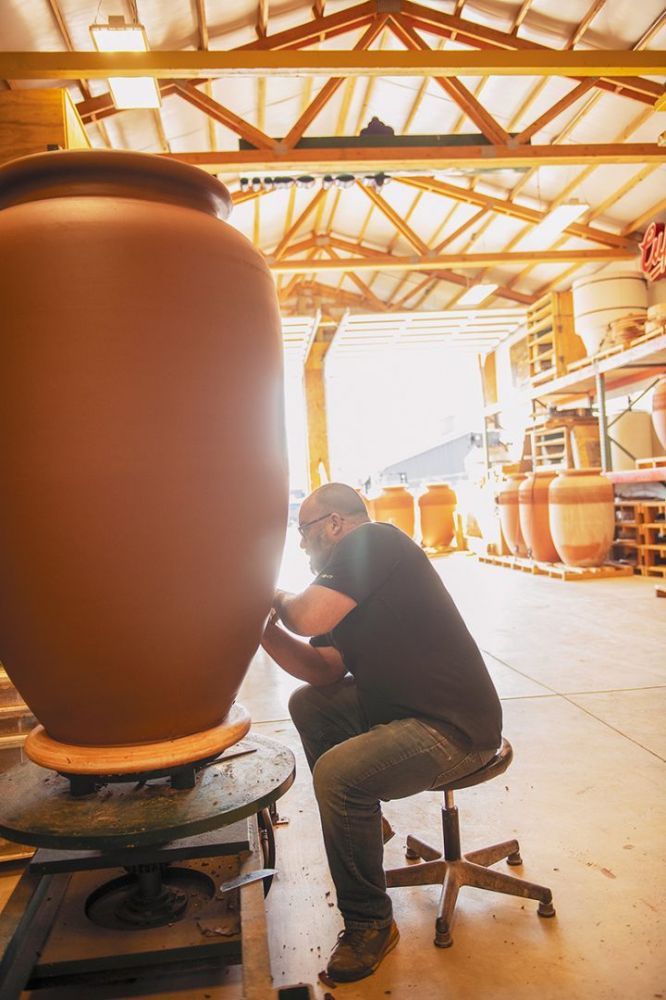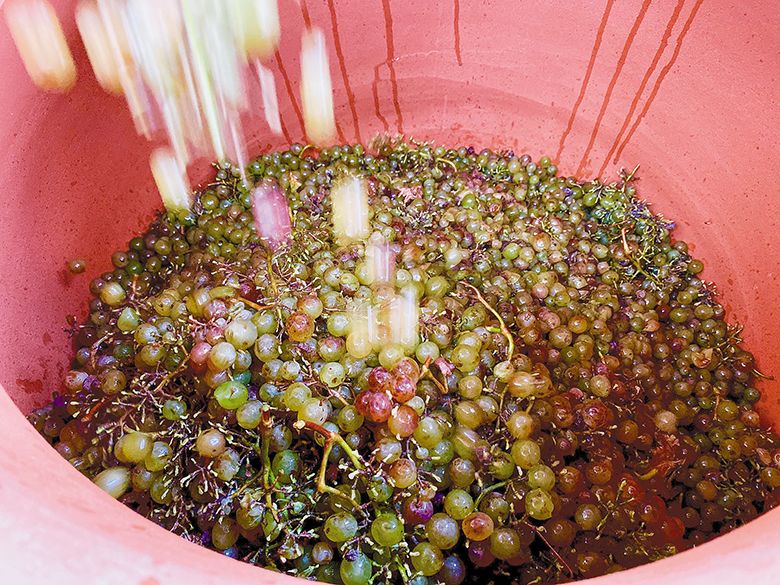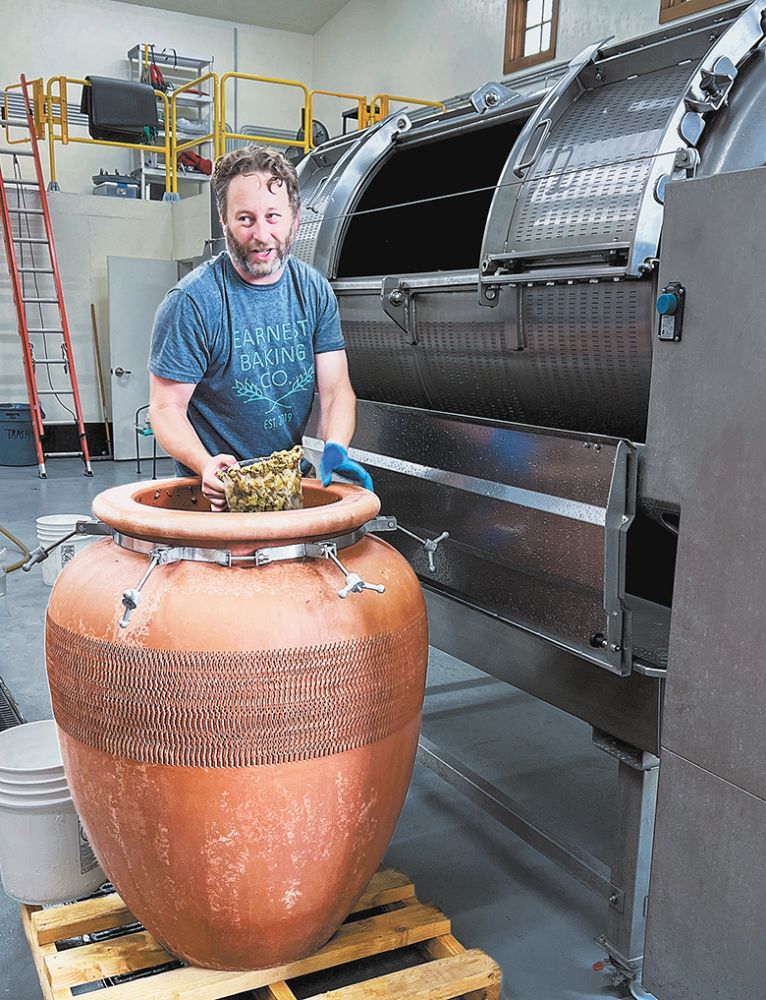New Meets Old Part One
Ancient winemaking techniques in the modern world



By Andrea Jacoby Oshell
In the beginning… there was wine. Well, maybe not from the start, but humans quickly developed fermentation. According to Armenian Christians, after the flood, Noah descended from Mount Ararat (in present-day Eastern Turkey near the Armenian border), planted a vineyard, made wine and got plastered. The history of wine has very early foundations. In the newest SOMM documentary, “Cup of Salvation,” Armenian pioneer winemakers Vahe and Aimee Keushguerian explore the history of winemaking, beginning 6,000 years ago in Armenia.
Today, a popular trend entails recognizing ancient world wines: where a wine originated and established winemaking methods. In Oregon, we have excellent wines made using old techniques and boutique shops selling wines from the ancient world. I will explore both in this two-part series.
Organic, biodynamic, natural, and minimal intervention represent popular styles of winemaking and grape growing. Yet, many of today’s winemaking practices were originally developed thousands of years ago: fermenting spontaneously with wild yeasts, using clay amphora and no additives. Arguably, the use of sulfur dioxide could be considered an ancient winemaking additive. It has been used since Egyptian and Roman times to prevent spoilage and sterilize amphora.
Modern Wine, Ancient Techniques
In Oregon, we feel fortunate to have a wide range of grape varieties and different wine styles. Although our winemaking history is still comparatively young, ancient world techniques are crucial for many winemakers.
The Potter’s Hands
Beckham Estate Vineyard co-founder Andrew Beckham, a potter for over 35 years, longed for “a potter’s studio in the woods.” In 2004, after discovering his dream property on Parrett Mountain, he began clearing the land for a vineyard, postponing the pottery studio. A decade later, Beckham says, “my wife read an article on Azienda Agricola Foradori and the Spanish amphora Elisabetta Foradori was using in Northern Italy. I looked at the photos and told my wife, ‘I can make those.’”
Beckham did. He created his own brand of Oregon clay amphora, NOVUM, “which means ‘new beginning’ in Latin,” he says. Each amphora is made of a special proprietary blend, fired to a precise temperature. He also notes, “When I started the project, I imitated shapes from different cultures and time periods.” He remembers, “One of the most compelling discoveries I made was related to kinetic energy and movement. When the shape of the vessel is right, a churning motion, known as thermal stratification, occurs.” This allows the wine to soften naturally, much like sea glass. Most notably, NOVUM amphora have a positive impact on our environment. He states, “These vessels have the potential to last for hundreds of years and a footprint arguably less impactful than the consumption of oak for barrel production.”
Amphora, Beckham says, “builds a framework based on texture. The wines made in NOVUM have a particular mouthfeel similar to putting your tongue on a wet river rock or piece of slate– slightly dusty and chalky, but free of any aroma, flavor or sweetness often associated with French oak.” His unfiltered wines are made with minimal intervention and native yeast.
Wines to try:
AD Beckham 2022 Creta Pinot Noir: Beckham’s flagship wine, Creta (clay in Latin) is estate-grown Pinot Noir aged one year in NOVUM.
AD Beckham 2021 Pinot Gris: macerating on the skins for one year (another ancient winemaking technique), this white wine is made like a red, with tannins and a beautiful pink-ish gold color.
New School Winemaker, Old School Winemaking
Sara Garr, owner and “chief cellar rat” of Circadian Cellars, has embraced modern winemaking with ancient winemaking techniques since 2016. She recalls, “A great modern wine needs a story, something beyond the juice itself. It must capture the consumer’s imagination.”
Garr doesn’t own equipment or winery space. Instead, she uses her surrounding resources. She works closely with vineyard owners to find grapes farmed with high standards of sustainability and appreciates the way vineyards flourish in their own right. She has a strong affinity for Primitivo grown in the Applegate Valley.
The Primitivo grape has ancient history with roots in Croatia’s Dalmatian Coast. After becoming popular in Italy, it was brought to California, as Zinfandel. Garr states, “Circadian’s comes from a single varietal vineyard planted in 2007 on rocky Manita loam surrounded by oak and madrone wooded hills. There it’s quiet enough to hear a pin drop.” She embraces the grape’s imperfections and challenges, noting, “Primitivo as a varietal has large, blue-ish/purple clusters that tend to ripen unevenly. This unevenness is exacerbated by inconsistent vine health row by row and plant. Most winemakers see this as a disadvantage, but I do not.”
Garr uses 50 percent whole cluster fermentation and foot treading, common techniques from the past. “After a few days of cold soak, I kick off my Blundstones, wash my feet and gently tread the must, creating more juice so the fermentation can start to percolate,” says Garr. This method allows her fruit to ferment spontaneously so the “wee beasties can rage!”
Wines to try:
Circadian Cellars 2020 skin contact Vermentino: foot stomped and left on the skins, it’s a lightly amber-colored wine with soft tannins and generous umami notes.
Circadian Cellars 2021 Primitivo: Fifty percent whole cluster carbonic maceration with bright, crunchy red fruit flavors. Serve slightly chilled at your favorite BBQ.
Ancient Farming, Ancient Wine
Troon Vineyard in Southern Oregon’s Applegate Valley, hasn’t always relied on ancient winemaking techniques. The vineyard, planted in 1972, underwent a major overhaul after Denise and Bryan White purchased the 100-acre property in 2016. After years of new farming practices, several soil tests and evaluations, Troon became the first Oregon vineyard and farm to earn both Demeter Biodynamic as well as Regenerative Organic certifications in 2021.
Nate Wall, Troon’s winemaker, says, “I strive to maintain the integrity and purity of the grapes throughout the winemaking process… revealing what I believe is a true expression of the varieties themselves along with our unique terroir.” Wall doesn’t differentiate between modern and ancient winemaking techniques. Instead, he practices minimal intervention production with integrity.
“We don’t manipulate the juice chemistry, flavors, colors, textures, etc. With gentle extraction (fermenting wines receive a single simple punch down or foot treading each day), plus lower fermentation temperatures, we retain the fundamental character of each grape variety,” says Wall. “Most importantly, rather than sterilizing the juice at crush and then fermenting the wines with a monoculture of a single commercial yeast strain, we allow natural fermentation, thereby preserving the full complexity of the entire microbiome.”
Wall says, “I age the finished wines in several different vessels, including NOVUM amphora, various concrete vessels and very neutral oak barrels. Amphorae (and the similar Georgian qvevri) have been used in winemaking for several millennia. While oak barrels do have a rather long history as a sturdier storage vessel than clay amphorae, the more recent use of new or almost new oak barrels dramatically alters the flavors and textures of the wine. This was not done in ancient times, and we do not do it at Troon either.”
Walls’ straightforward sentiment on ancient world winemaking includes a strong passion for the style. “Seeing and tasting well-crafted wines from ancient techniques may have more conventional winemakers questioning some of what they were taught as the ‘rules’ of modern winemaking… Thoughtfully applied, these practices can lead to even more diversity in the already dizzying array of choices available to wine consumers– a win for everyone!”
Wines to try:
Troon Vineyard 2021 Amphora Amber: an excellent example of wine made in amphora, coupled with Troon’s long history of crafting Vermentino. Lovely notes of crisp apple, blossoms and dusty tannins.
Troon Vineyard 2022 Siskiyou Syrah: screaming acidity and cool notes of blueberry and blackberry reflect a more Northern Rhône-style Syrah.
Drinking Ancient History
Enjoying wines made with ancient techniques return us to our roots. Modern winemakers continue using methods established over thousands of years, so pour these wines and thank our ancient winemakers. (Read part two in next month's issue.)
Andrea Jacoby OShell has been in the wine industry for over a decade first discovering her love of wine at a small neighborhood wine shop in Miamisburg, Ohio. She also discovered her love of writing during that time by writing and publishing background guides for the International Model United Nations Organization. She moved to Oregon in 2015 where her wine journey continued. She resides in Southern Oregon and currently works for a small wine distributor. She also achieved her WSET level III with merit in 2021. In her spare time, you can usually find her meandering through old East Medford with her two dogs, Teddy and Luna.










